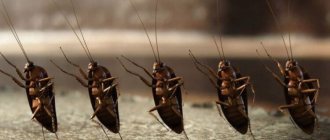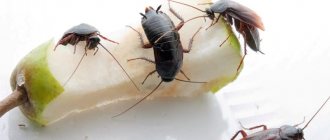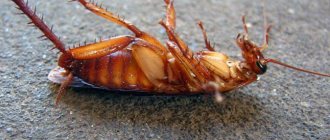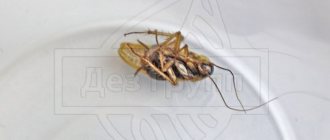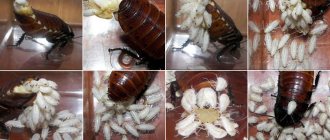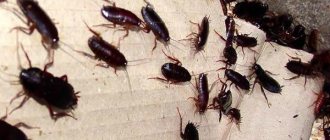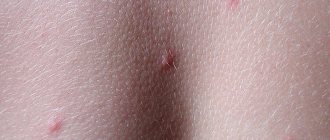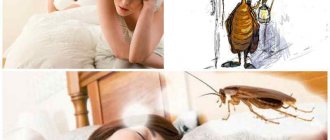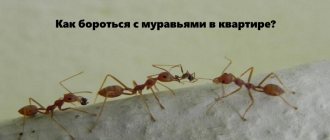- General characteristics of domestic cockroaches
- Reproduction
- Types of domestic cockroaches, harmful and exotic (bred), their characteristics Red cockroaches
- Black beetle
- American cockroach
- Furniture cockroach
- Vietnamese (Turkestan) cockroaches
- Egyptian cockroaches
- Madagascar cockroach
- Rhino cockroach
- Chess cockroach
- banana cockroach
- Forest cockroach
- Little car
- Dead Head
- Marbled (ash) cockroach
- Sarawak cockroach
- Megalobat cockroach
- Lapland cockroach
- Asiatic
- Blaberus cockroaches
- Prevention
Everyone has heard about cockroaches. But some are lucky enough to admire the brilliant Madagascar giants in the aquarium, while others unsuccessfully poison local, red or black pests in their kitchen. This nimble insect is found on all continents except the edge of permafrost. They love rotting plants, warmth and humidity, so the most arrogant representatives moved closer to garbage bins, and from there to human houses.
What types of these parasites are the most common, why are they dangerous, and how to fight them?
General characteristics of domestic cockroaches
All representatives of cockroaches have an elongated, flattened, oval-shaped body. Sizes vary from 1 to 10 cm (and more). There are tergites (segments) on the body - up to 10 in the male, up to 7 in the female. The wings are transparent, with membranes, hidden under dense elytra. Many species fly. The legs are adapted for fast running, with spikes. The ovipositor is hidden in females.
The flat head is heart-shaped, with a protective plate from the back. Long antennae with bristles. The jaws are powerful, with sharp chitinous teeth. The eyes are large and atrophied in wingless representatives.
Almost all species of this unpleasant insect love comfortable conditions in the form of warm and humid places, prefer night life, and during the day they hide under stones, leaves, bark and in similar hiding places in human habitation. At night they climb and fly into bright light.
They are considered extremely hardy. They are not afraid of hunger or radiation, and almost immediately develop resistance to most poisons. Can withstand radiation levels 15 times higher than humans (safe levels of radiation will depend on developmental stage).
They can go without food for up to 4 weeks, but are practically omnivorous. They love sweets and fatty foods, but with their mega jaws they grind everything from leather, books, wood to feces and any waste. They enjoy eating plants, fruits and vegetables. Males eat up to 30 g per day, while females can eat up to 50 g.
Insecticidal gels
This insecticide format is in high demand due to its ease of use. As a rule, the gel is placed in a special plastic tube with a long tip spout. The gel is applied pointwise around the perimeter of the apartment in small drops: under baseboards, on cabinets, mezzanines, and so on. The substance acts on the domino principle: one cockroach, having tasted the poison, will certainly infect its fellows, provoking an entire epidemic.
The gel contains a fatty substance that prevents drying, a fragrance to attract insects and an insecticide. The advantages of the gel include the following:
- Speed of action.
Within a week, only unpleasant memories will remain from cockroaches.
- Long lasting effect.
The product remains active for several months (up to a year), so you don’t have to worry that after insecticidal measures the pests will start again.
- Protection from being eaten by animals or children.
A special bitter substance is added to gel insecticides, which repels pets - you don’t have to be afraid that your beloved Murka will lick off all the cockroach poison. The most popular gels are:
- Raptor;
- Global;
- Absolute.
These are insecticides based on chlorpyrifos, a toxic substance that, when entering the body orally, blocks the functioning of the insect’s nervous system. There are gels that kill parasites not only from the inside, but also from the outside:
- Combat;
- Dohlox;
- Brownie.
The principle of action of these drugs is based on the content of a special substance, which, upon contact with the chitinous shell, blocks the functioning of the nervous system. A few hours later, when the cockroach returns to its relatives and manages to infect them, complete paralysis occurs. So, according to the domino principle, an entire population dies out.
Reproduction
The ability to increase the population of this family is amazing. There are 2 ways - sexual or parthenogenetic, but in any case at least one mating must occur. The eggs are located in a special capsule (ootheca). Females carry this protein “suitcase” at the end of their body (most species), others are viviparous. Cockroaches have complex behavior as parents.
Go through 3 stages of development:
- Egg.
- Larva or nymph.
- Imago or adult individual.
They develop from larvae to adults through molting (up to 8 times). The maturation process for Prussians (red cockroaches) takes several months, while for black cockroaches it takes 4 years.
Example of a viviparous species:
Nymphs of longhorned beetles develop for a couple of months, and black representatives for several years (4 years). During this time, molting occurs (shedding of the old chitinous shell), and the “newborn” individual becomes larger each time. In total, up to 9 molts occur.
Each species goes through certain stages in its development. So, during molting, the cockroach sheds its brown chitinous outfit, remaining in translucent white “underwear”. Therefore, in a couple of days the running white pest will become similar to its relatives. Sometimes whiteness is explained by the use of chlorine-containing preparations, which tend to oxidize and bleach surfaces, including chitin.
Representatives of cockroaches in our homes
Sometimes white representatives of this species are found, but people do not realize that the white pests running around the kitchen are actually ordinary Prussians who have recently shed their old shell, and the new one has not had time to acquire a dark color.
A Turkmen pest is found in Kazakhstan, which is often kept in terrariums by exotic lovers. This species grows up to 7 cm and is orange in color.
Egyptian or ash insects are interesting because they feed on wood, like termites. They live in northern Africa.
Banana pests are bright green in color, which helps them hide from predators in the vegetation. Africa is considered the homeland of this species.
And of course, you can’t miss the Madagascar giant, which is often kept in terrariums. This species is also often bred as food for other exotic animals.
Types of domestic cockroaches, harmful and exotic (bred), their characteristics
More than 4,500 species are now known, of which only 55 species are found in the CIS. And apartments are inhabited by only 3 species: red (Prussian), black and American.
Red cockroaches
Prusaks, or red cockroaches, can fly, but not for long. Adults come in different colors and are up to 1.6 cm long. They live in colonies. Life expectancy is about 6 months from the moment of hatching. They practically never meet without a person.
Males are oblong, wings peek out from under the elytra. Can fly short distances. Females are more rounded, without clearly defined wings. At one time, up to 40 eggs are laid in a capsule, which is worn for 2-4 weeks until the nymphs emerge from it. Nymphs are darker than adults and have no wings. After 2 months and 6 molts, the nymph turns into an adult.
After molting, the cockroach is much lighter, translucent, but this passes quickly, after 1-2 days they darken. Adults live up to 4 months. Over the course of her entire life, the female makes 4-9 clutches in the ootheca, that is, up to 400 eggs from one individual in just six months.
Their homeland is southern Asia, so they cannot tolerate cold at all, so when cooled to -5°C they die, and they feel so good in human habitation. The Prusak is omnivorous; in case of hunger strike, it can even chew soap or plaster. Does not tolerate thirst well.
Black beetle
They are much less common than redheads. They, unlike the Prussians, can live both among people and in the wild, not far from human habitation. They prefer warm, damp places (sewers, mines). The size of an adult cockroach reaches 8 cm. Representatives of this species run fast, but cannot fly.
American cockroach
Large (up to 5 cm), with a red-brown shell. Capable of running up to 75 cm/sec, while changing directions of movement up to 25 times. It flies, but rarely. It is impossible to catch with your hands. They have a powerful mouthparts (they chew through pieces of wood and plastic) and eat everything, even hair and shoes.
Very thermophilic - they die in minimal frost. They live in huge colonies (tens of thousands of individuals).
During mating games, the male runs around the female and flaps his wings. This is due to the pheromones secreted by the lady. After fertilization, the pregnant female first carries a capsule with eggs (up to 2 days), after which she buries the ootheca into the substrate. BUT! The female can lay eggs without fertilization by the male.
Furniture cockroach
Officially recorded only 100 years ago. Similar to Prussians, but smaller (up to 1.2 cm). The body shape and shade may vary, but the main feature is 2 stripes along the body. The color of these pests ranges from bright brown with a red tint to almost black. They run and jump very fast.
They tolerate a lack of water more easily than other species; they love starchy food (any paper, paste). The optimal temperature is about 30°C and high humidity.
Vietnamese (Turkestan) cockroaches
They live in houses, in landfills, and in the wild. Yellow, with a dark brown tint. An important feature of this species is jumping and flying. They consume plant remains and debris from human activities.
Egyptian cockroaches
These pests live in Asia, in the Caucasus and Crimean mountains. The brown color and rounded body shape make this species look like a turtle. Males are winged, females are not. Large (up to 4.5 cm), they live on farms, in houses, and animal burrows. They eat all types of organic waste, including excrement. They can starve for more than 3 months, but the lack of water is critical for them.
At one time, the female lays up to 18 eggs; in total, she can lay up to 5 ovipositions during her life. It takes 2 years from birth to adulthood, during which time it sheds several times. The adult stage lasts another 2 years.
The harm from this type of cockroach is enormous, since after eating the insects, the animals become infected with paratyphoid.
Madagascar cockroach
Giant individuals (up to 10 cm) are known for their hissing. This is how they try to scare the enemy. Unpretentious, omnivorous. These are viviparous insects. They prefer humidity and warmth, like representatives of other species of the cockroach family. They are bred as pets or as food for snakes and lizards.
Rhino cockroach
A large beetle up to 8 cm and weighing about 35 g (only 2 times lighter than a sparrow). Chocolate color. A good digger, excellent at digging tunnels. It is massive (40 g). Consumes parts of plants, but will not refuse particles of dead animals.
Rhinoceroses are clean and do not smell. They do not fly and cannot crawl on glass, so they are excellent for keeping in aquariums.
Chess cockroach
Representatives of this species stand out among their relatives with their beautiful checkerboard colors. Found in India. They grow up to 3 cm. They love warmth and moisture (above 70%), prefer night walks.
banana cockroach
It has an unusual green color. Can fly. Prefers to live on banana plantations, consuming parts of plants and fruits.
Forest cockroach
An inconspicuous inhabitant of wooded areas (up to 11 mm), eats everything it finds (all kinds of greenery, carrion). During the day it hides under the grass or in the roots of bushes and trees. Translucent body of brown-golden color. There is a black spot on the head, the wings extend behind the body. It is not very dangerous for humans, as it cannot even bite through the skin of a finger.
Little car
They got their name thanks to two spots on their head that look like car headlights. They reach 5 cm and prefer not to be seen by people. They grow slowly, love mating games and competition for the female. They don’t fly or crawl on glass, so they often join the ranks of pets.
Dead Head
This large insect (up to 5.5 cm) received its name due to its frightening colors. It eats small insects, and if there is a lack of food, it will not disdain its relatives.
Marbled (ash) cockroach
It comes from Africa, but is found in most countries, as it is very undemanding to conditions and food, and reproduces well. It is also called naufet. The insect reaches 3 cm.
It feeds on raw vegetables, fruits, various grains, flour products, and does not disdain paper and thin plastic. They can eat each other when there is a lack of food. Often grown to feed reptiles and large spiders.
Sarawak cockroach
The difference between this species and others is the ability of the larvae to swim well. They prefer to live close to sources of moisture; in case of danger, they can dive to the bottom and hide there. Otherwise, their habits are like those of other relatives.
Megalobat cockroach
This longhorned beetle is hard to miss - Megaloblatta longipennis is considered the largest representative (9.7 cm by 4.5 cm in width). And its close relative (Megaloblatta blaberoides) has the largest wingspan (18.5 cm).
Lapland cockroach
Brown-brown, with a black dot, reminiscent of dry leaves. Found in Europe and America. Reaches a length of 1.4 cm. Fast, not demanding.
Asiatic
Found in areas with a tropical climate. The closest relative of the Prussian. Prefers to live outside, hiding under a layer of leaves. The population increases in the warm season and decreases in the fall.
Blaberus cockroaches
Large and colorful Blaberus giganteus hides well among foliage and grass. Found in various parts of America. They grow up to 9 cm in length.
Double tails / Diplura
And although this insect does not belong to the cockroach order, the editors of most-beauty decided to add it to our list because of its interesting features. In damp places you can find an unusual species of arthropods, commonly called earwigs. They have a terrifying appearance.
Adults grow up to 6 cm in length, and at the back they have long cerci, like pitchforks. It is they who give the creature a terrifying appearance. On the head, like everyone else, there are long mustaches and powerful biting mandibles.
They are not dangerous to humans, but only bite painfully for protection purposes. But, settling in a house, they can become carriers of diseases and infections. Sometimes they are afraid that they can crawl into the ear, but this happens quite rarely.
Danger of cockroaches
In addition to their frightening appearance, these insects are dangerous because, while moving and absorbing waste and excrement, they carry worm eggs on their bodies, and are carriers of many infectious diseases.
Moving from garbage to food products, cockroaches carry most intestinal infections, especially dysentery, gastroenteritis and diarrhea. Constant shedding provokes allergies to chitin and dust. There are known cases when longhorned beetles climbed into the ears of sleeping people, and also gnawed the skin on the eyelids and ears.
Popular questions
When small cockroaches appear, many wonder whether these insects are the cubs of large red locusts. Despite some superficial similarities, this is not the case. Despite their small size, small cockroaches are adults, imagoes. The larvae of parasites have a lighter, soft chitinous cover.
Do I need to get rid of cockroaches if there are few of them? Necessarily. Even if just one parasite appears, you need to immediately take measures to help get rid of the insects and prevent their spread. Given favorable conditions, parasites multiply at an incredible rate; getting rid of a colony of several hundred individuals is extremely difficult.
Interesting facts about cockroaches
Giants from Madagascar make excellent pets. Bright, large (up to 10 cm), they crack and hiss in a funny way. They are unpretentious and eat everything, even dry bread or fish food. They are also used for running. Often eaten in Asia and South America.
Black pests from this family were used as a folk remedy for kidney diseases, to stop an asthma attack, and to get rid of helminths. Fried cockroaches were given for diarrhea, and tea made from dried longhorned beetles was given for dropsy.
In the old days, it was believed that cockroaches lived only where there was plenty, so they were taken with them to a new home.
Headless barbels die from dehydration, not from their body being decapitated.
Traces of cockroaches were found in layers older than 320 million years.
Where do they come from?
In an apartment, large cockroaches usually appear from the sewer or garbage disposal. Sometimes parasites enter a room by moving from neighbors. There may be another option when insects flee from pest control and end up in your apartment. This situation is not uncommon if you live on the 2nd floor, and on the 1st there is a cafe or store.
At the same time, cockroaches use ventilation as their path. It is easy to bring pests into your home on your own clothes or belongings after you have visited where they live. Longhorned beetles may also end up in an apartment with vegetables and fruits brought from the store.
The best treat
These insects are often bred to feed fish, reptiles, and spiders. They multiply quickly, eat everything, don’t get sick, and completely survive. Cockroaches are loved by certain types of scorpions, cats, hedgehogs, hamsters, large lizards, frogs, chickens and even ants (they disassemble dead individuals into pieces).
But the most promising direction is cockroaches as a source of protein. In terms of the content of this nutritional component, they are 3 times higher than chicken. In China, they love fried crunchies sprinkled with sugar.
Appearance
In addition to their huge size, black cockroaches have some other features of their appearance. Thus, the body color of the pest is not red, but pitch-black or black-brown, giving off a metallic sheen. On the head of an insect, in addition to the mustache, there are hairs. The animal is not capable of flying, but it runs very fast.
Like the red cockroach, the black cockroach loves darkness and is active at night. “Domestic” black parasites have excellent vision and are able to distinguish odors. Their structure allows you to climb even seemingly inaccessible places.
The main difference between individuals of different sexes is the size of their elytra. In males this organ is shorter than the abdomen, but in females it covers the body completely.
In an apartment, barbels are attracted by the availability of food and accompanying living conditions. They are mainly attracted by dampness, a bucket full of garbage, dirty dishes, crumbs on the floor, table and unprotected food. The mouth of insects is organized in such a way that it allows them to absorb even solid food. The bacteria living in the parasite's intestines digest almost everything.
The cockroach usually eats garbage and food waste. If there is a shortage of these products, the pest can consume fabric, soap, paper, and even fellow insects. Cannibalism is a common occurrence among this species of animal. The creature usually does not bite humans. However, those with delicate skin, in particular children, may experience bite marks around the lips and on the fingers in the morning.
Measures to combat cockroaches
Man has been fighting cockroaches for a hundred years and losing most of his battles. Incredible vitality, speed of reproduction, the ability to eat everything in a row or even go hungry, and almost instantaneous addiction to most poisons make the mustachioed guest a strong adversary. But it is possible to get it out.
To get rid of cockroaches of any kind, you should follow 5 basic rules:
- Maintain cleanliness.
- Deprive insects of food and water.
- Use insecticides to which pests are not yet accustomed.
- Seal the room.
- Use auxiliary techniques (freezing).
But even after getting rid of the longhorned beetles, you cannot stop fighting, since the winged invaders very quickly return or run away from their neighbors.
Prevention
It’s not for nothing that cockroaches are the first sign of neglect and unsanitary conditions. The more rubbish, crumbs, garbage, the more likely it is that they will choose the room. No insecticides will help, creating only a temporary effect. Unwanted neighbors can hide in cracks, feed on leftover food in the trash can or on the table, and raise larvae in secluded, damp places.
To exclude all ways of entry and reproduction of longhorned beetles, you should constantly remove leftover food, do not leave garbage overnight, and do not accumulate. Be sure to clean any places where cockroaches can hide: cracks, peeled wallpaper, baseboards, cracks in the floor and windows, various secluded places in the closet, bathroom, on an insulated balcony.
The first and main condition for removing pests is cleanliness, no food particles, and places where you can hide. Some cosmetic repairs wouldn't hurt.
Anything that mustachioed parasites can use as food should be removed. And this is garbage, crumbs, any products, even those that have expired or smell bad.
But if cockroaches can live for a very long time without food (up to a month), without water it is much more difficult for them. Therefore, any sources of moisture should be removed from the area being treated. Drops of condensation, remaining water in the sink or bathtub, an open toilet, an aquarium, moisture in flowerpots with plants - all this allows the cockroach to drink.
It is especially important to deprive the barbel of moisture during etching. Thirst forces insects to eat more gel-like baits, the poison is absorbed faster and the effect of destruction will be rapid and massive.
Insecticides to the rescue
There are hundreds of medications for cockroaches, but they are all based on several dozen active ingredients. And these ancient insects (the remains of their ancestors were found in layers more than 300 million years ago!) get used to any poison after several uses.
When choosing a product, you should evaluate several criteria:
- Effective against cockroaches.
- Safety for humans.
- Ease of use.
A long-known substance that is still effective against cockroaches, and is practically harmless to warm-blooded animals and humans. This is boric acid and its derivatives, which mustachioed parasites happily absorb if it is hidden in strong-smelling baits (egg yolk, boiled liver, vanilla dough).
It is enough to use this remedy, and after the population decreases, maintain additional factors so that the insects do not multiply again and do not come from neighbors.
Cockroach repellents are produced in the following forms:
- powders/dusts;
- gels;
- aerosols.
Viscous forms of insecticides are applied to sticky tapes, adhesive baits, and traps. Dry ones are used in granules, crayons, powder, tablets or diluted for application as a suspension. Liquid - in the form of aerosols or solutions for lubricating surfaces.
To treat premises against cockroaches, agents of intestinal, respiratory, contact and systemic action are used. Many modern drugs contain various types of substances, which increases their effectiveness.
Based on the active substance, products are divided into the following groups:
- Avermectins – can only be used in concentrations below 0.02%. Very dangerous for fish and other aquatic inhabitants;
- derivatives of boric acid - not very dangerous for humans, harmful to plants;
- fipronil is a moderately toxic substance, especially for the nervous system, effective, does not penetrate human skin;
- hydramethionone – with low toxicity. Dangerous for residents of ponds and aquariums;
- indoxacarb is very dangerous for aquatic inhabitants. The cumulative effect and acute toxicity at high concentrations are dangerous for humans;
- growth regulators - causes irritation of mucous membranes, generally low toxicity;
- pyrethroids are dangerous for bees and aquatic pets. Dangerous for humans due to allergenicity and harmful effects on the respiratory system, toxic to the nervous system;
- neonicotinoids are moderately toxic and penetrate the skin. Dangerous for the nervous system, can cause a sterilizing effect. Toxic to bees and aquatic animals;
- FOS - dangerous for all living organisms, especially for children;
- Methyl cabamates are highly toxic even in small quantities. They have a sterilizing effect.
Some substances are effective against adult insects, but have no effect against larvae. They need to treat the room at least 2-3 times, first against the adult individuals that are available, then against those that have hatched from laid eggs.
There are substances that act only against imagoes. There are drugs that sterilize pests. The effect of their influence is noticeable no earlier than a month later. Therefore, it is so important to strictly follow the manufacturer's instructions.
Tightness is a step to victory
When the local cockroaches disappear, but the neighbors remain, there is a high probability that their mustachioed residents will move into a clean room. Therefore, complete tightness should be achieved:
- seal the cracks at doors and windows;
- during the warm season, close the vents and windows with sealed mesh;
- close the ventilation holes with a dense mesh or grille;
- seal cracks in the floor, behind skirting boards, and at pipe entry points;
- close the toilet with a tight lid and plug the drain holes of sinks and bathtubs.
These measures will protect the apartment from defectors. Only a set of measures allows you to vacate the premises guaranteed and for a long time.
Folk remedies and auxiliary
One of the most effective ways to eliminate a colony of cockroaches is freezing - cooling the room to a temperature below -5°C. But this is difficult to do with a residential apartment, since filled heating pipes will burst if everything is cooled down so much.
Electric traps are also used as an aid. At the smell of the bait, barbels come running and are instantly killed by a slight electric discharge. They are effective only against adult insects and do not provide 100% destruction of the population.
Less common are ultrasonic repellers, which are best used in clean areas as an additional remedy against “dirty” neighbors.
Professional etching
In some cases, you cannot do without professional help:
- population size is too large;
- owners cannot get rid of it on their own;
- you need to poison the cockroaches quickly and all at once;
- the area is too large or due to other reasons.
Many companies offer their services to combat insects. You can find out the price of such etching in advance and evaluate all the pros and cons.
Can whiskered pests cause allergies?
Cockroaches are dangerous in terms of causing an allergic reaction in people. During their life, parasites leave chitinous shells (after molting) and hardened feces everywhere. This mixes with dust and when it gets into the lungs or onto the epidermis, it causes the development of a number of diseases:
- asthma;
- dermatitis;
- allergic rhinitis;
- conjunctivitis.
When faced systematically with an allergen in the home, a person develops a chronic allergy - the symptoms do not go away. Children are especially susceptible to this. Signs of an allergic reaction: sneezing, watery eyes, soreness and congestion in the nasopharynx, pain in the eyes.
Prolonged rhinitis threatens to develop into polyps in the nose, which leads to serious breathing problems. Asthma not only causes general malaise, but also significantly disrupts the usual way of life.
Black cockroaches constantly emit an unpleasant stench. If the accumulation is small, this is not so noticeable, but if the infection is severe, the stale smell lingers in the apartment constantly. No amount of ventilation can eliminate it. There is only one way to get rid of it - to completely poison the parasites and remove the remains that have accumulated in secluded places in the living space.
Stages of insect development
Prussians and their black relatives are very different from each other in appearance. Black insects are much larger than red ones. Their larvae are also larger in size than baby Prussians. The female insect lays her eggs in a special chitinous shell - the ooteca. In the black representative of cockroaches, up to 20 larvae are formed in one clutch. The life cycle of a large barbel consists of several stages:
- The ootheca remains for about 1.5 months in a warm, secluded place, after which nymphs emerge from it;
- the larva is formed within 7–8 months, shedding its chitinous shell and acquiring a new one;
- The adult is capable of reproduction and can lay more than 20 oothecae during its life of up to 5 years.
Red representatives of cockroaches develop in a similar way, but the duration of their cycles is shorter:
- The ootheca left by the female releases from 25 to 40 small cockroaches within 2 weeks;
- the larval stage lasts 2 – 4 months;
- On average, the imago lives a short life of 1 year, during which time it manages to give birth to offspring about 10 times.
If we compare the two most common types of pests, then the rate of development of the organism in red ones exceeds their counterparts. Therefore, they have a greater chance of surviving in unfavorable situations. Small and nimble Prussians displace their larger competitors from the territory, putting them to flight or completely destroying the entire colony.
